Qualitative Research Review: COPD Patient Experience at WSU
VerifiedAdded on 2023/06/14
|7
|2140
|278
Report
AI Summary
This report provides a guided review of a qualitative research article focusing on Chronic Obstructive Pulmonary Disease (COPD) patients' experiences in identifying and managing exacerbations at home. The review covers the study's background, research design, sampling methods, data collection techniques, and data analysis. It examines the significance of the study, the appropriateness of the chosen research design, the characteristics of the participants, and the inclusion/exclusion criteria. The review also discusses the advantages and disadvantages of the data collection method used and suggests alternative methods. Furthermore, it evaluates the rigor of the data analysis and summarizes the study's findings, including the identification of visible and invisible symptoms by patients and their self-management strategies. The report concludes by suggesting settings to which these findings can be transferred, highlighting the study's contribution to understanding COPD patient experiences and informing future research and practice.
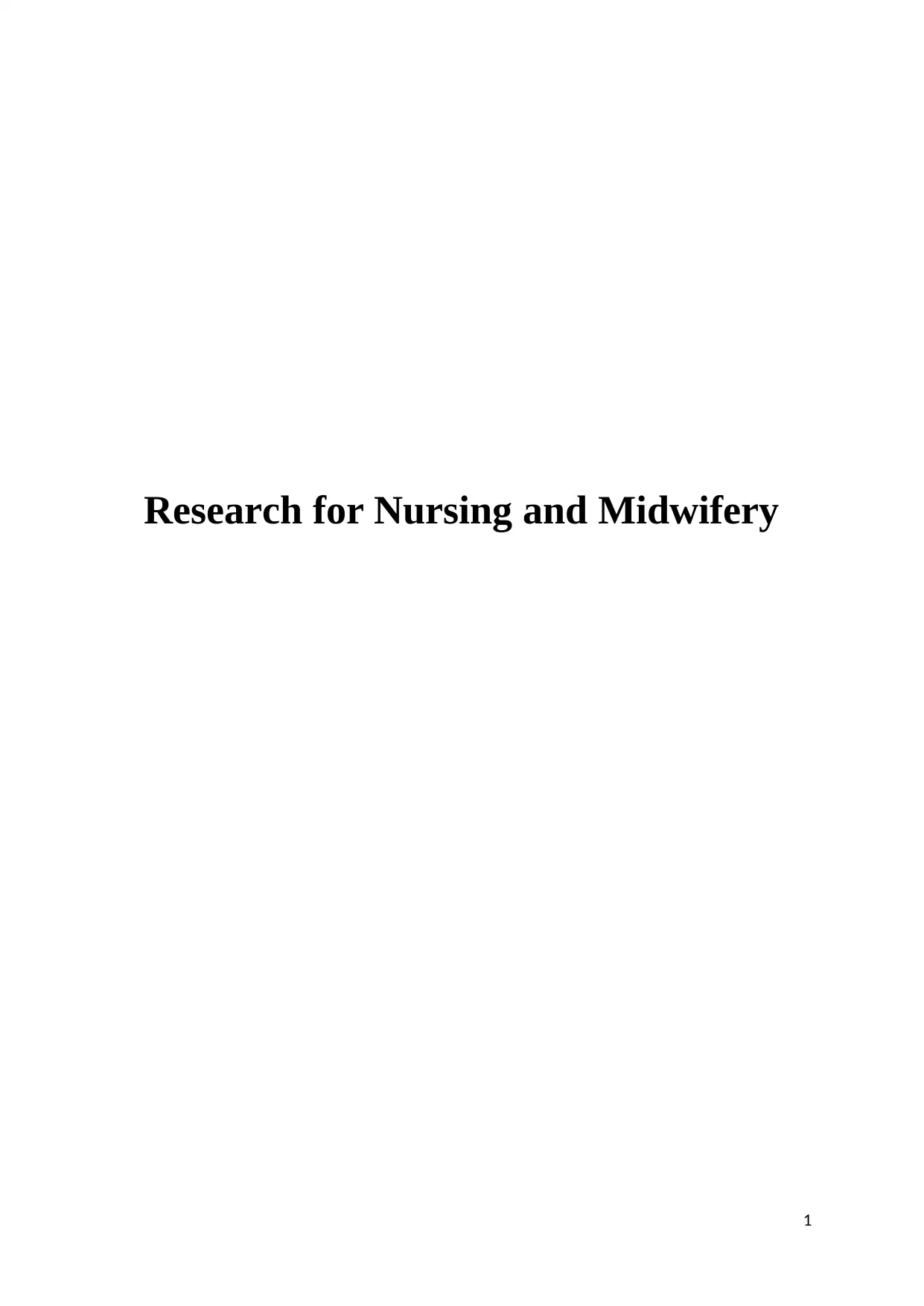
Research for Nursing and Midwifery
1
1
Paraphrase This Document
Need a fresh take? Get an instant paraphrase of this document with our AI Paraphraser
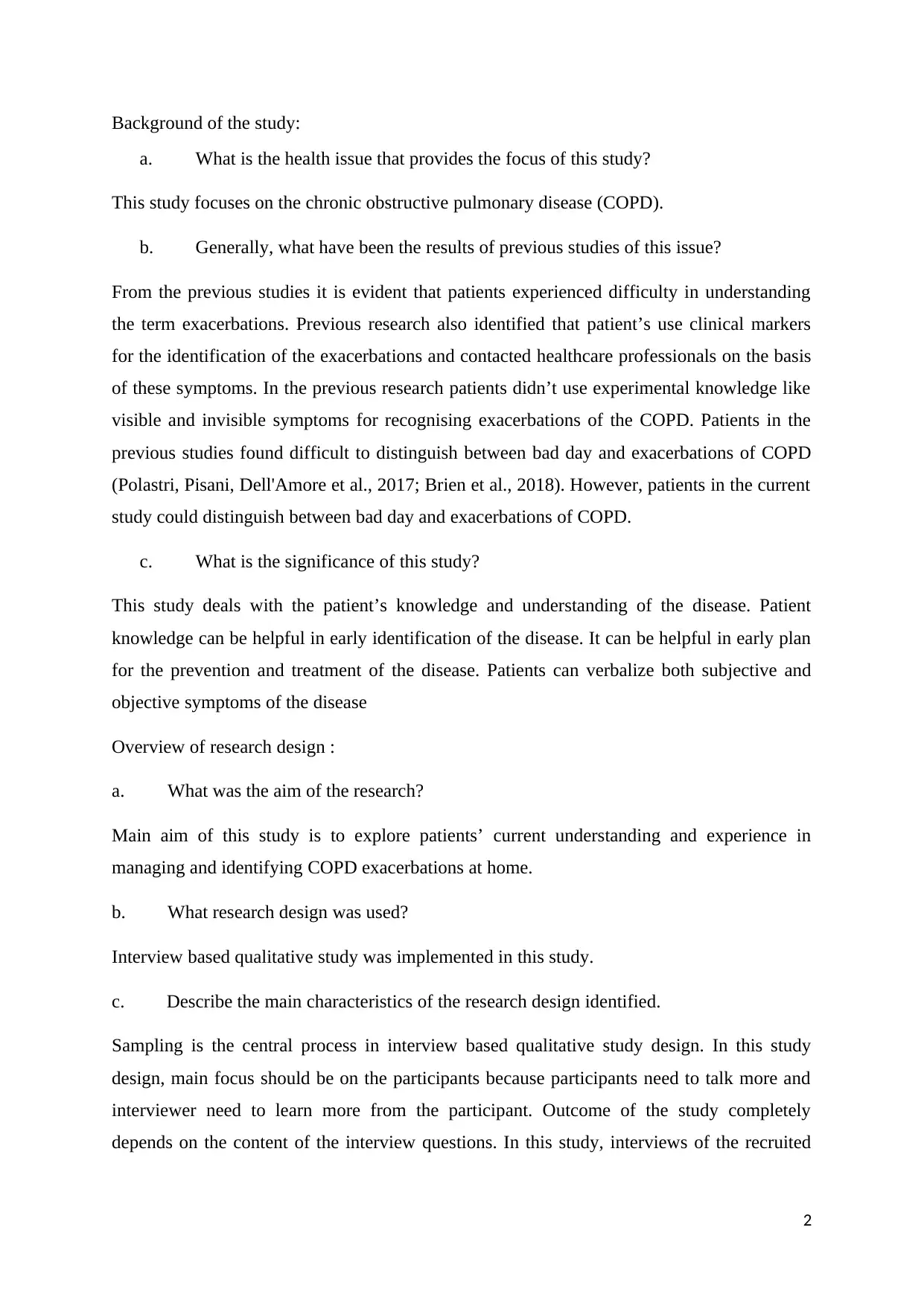
Background of the study:
a. What is the health issue that provides the focus of this study?
This study focuses on the chronic obstructive pulmonary disease (COPD).
b. Generally, what have been the results of previous studies of this issue?
From the previous studies it is evident that patients experienced difficulty in understanding
the term exacerbations. Previous research also identified that patient’s use clinical markers
for the identification of the exacerbations and contacted healthcare professionals on the basis
of these symptoms. In the previous research patients didn’t use experimental knowledge like
visible and invisible symptoms for recognising exacerbations of the COPD. Patients in the
previous studies found difficult to distinguish between bad day and exacerbations of COPD
(Polastri, Pisani, Dell'Amore et al., 2017; Brien et al., 2018). However, patients in the current
study could distinguish between bad day and exacerbations of COPD.
c. What is the significance of this study?
This study deals with the patient’s knowledge and understanding of the disease. Patient
knowledge can be helpful in early identification of the disease. It can be helpful in early plan
for the prevention and treatment of the disease. Patients can verbalize both subjective and
objective symptoms of the disease
Overview of research design :
a. What was the aim of the research?
Main aim of this study is to explore patients’ current understanding and experience in
managing and identifying COPD exacerbations at home.
b. What research design was used?
Interview based qualitative study was implemented in this study.
c. Describe the main characteristics of the research design identified.
Sampling is the central process in interview based qualitative study design. In this study
design, main focus should be on the participants because participants need to talk more and
interviewer need to learn more from the participant. Outcome of the study completely
depends on the content of the interview questions. In this study, interviews of the recruited
2
a. What is the health issue that provides the focus of this study?
This study focuses on the chronic obstructive pulmonary disease (COPD).
b. Generally, what have been the results of previous studies of this issue?
From the previous studies it is evident that patients experienced difficulty in understanding
the term exacerbations. Previous research also identified that patient’s use clinical markers
for the identification of the exacerbations and contacted healthcare professionals on the basis
of these symptoms. In the previous research patients didn’t use experimental knowledge like
visible and invisible symptoms for recognising exacerbations of the COPD. Patients in the
previous studies found difficult to distinguish between bad day and exacerbations of COPD
(Polastri, Pisani, Dell'Amore et al., 2017; Brien et al., 2018). However, patients in the current
study could distinguish between bad day and exacerbations of COPD.
c. What is the significance of this study?
This study deals with the patient’s knowledge and understanding of the disease. Patient
knowledge can be helpful in early identification of the disease. It can be helpful in early plan
for the prevention and treatment of the disease. Patients can verbalize both subjective and
objective symptoms of the disease
Overview of research design :
a. What was the aim of the research?
Main aim of this study is to explore patients’ current understanding and experience in
managing and identifying COPD exacerbations at home.
b. What research design was used?
Interview based qualitative study was implemented in this study.
c. Describe the main characteristics of the research design identified.
Sampling is the central process in interview based qualitative study design. In this study
design, main focus should be on the participants because participants need to talk more and
interviewer need to learn more from the participant. Outcome of the study completely
depends on the content of the interview questions. In this study, interviews of the recruited
2
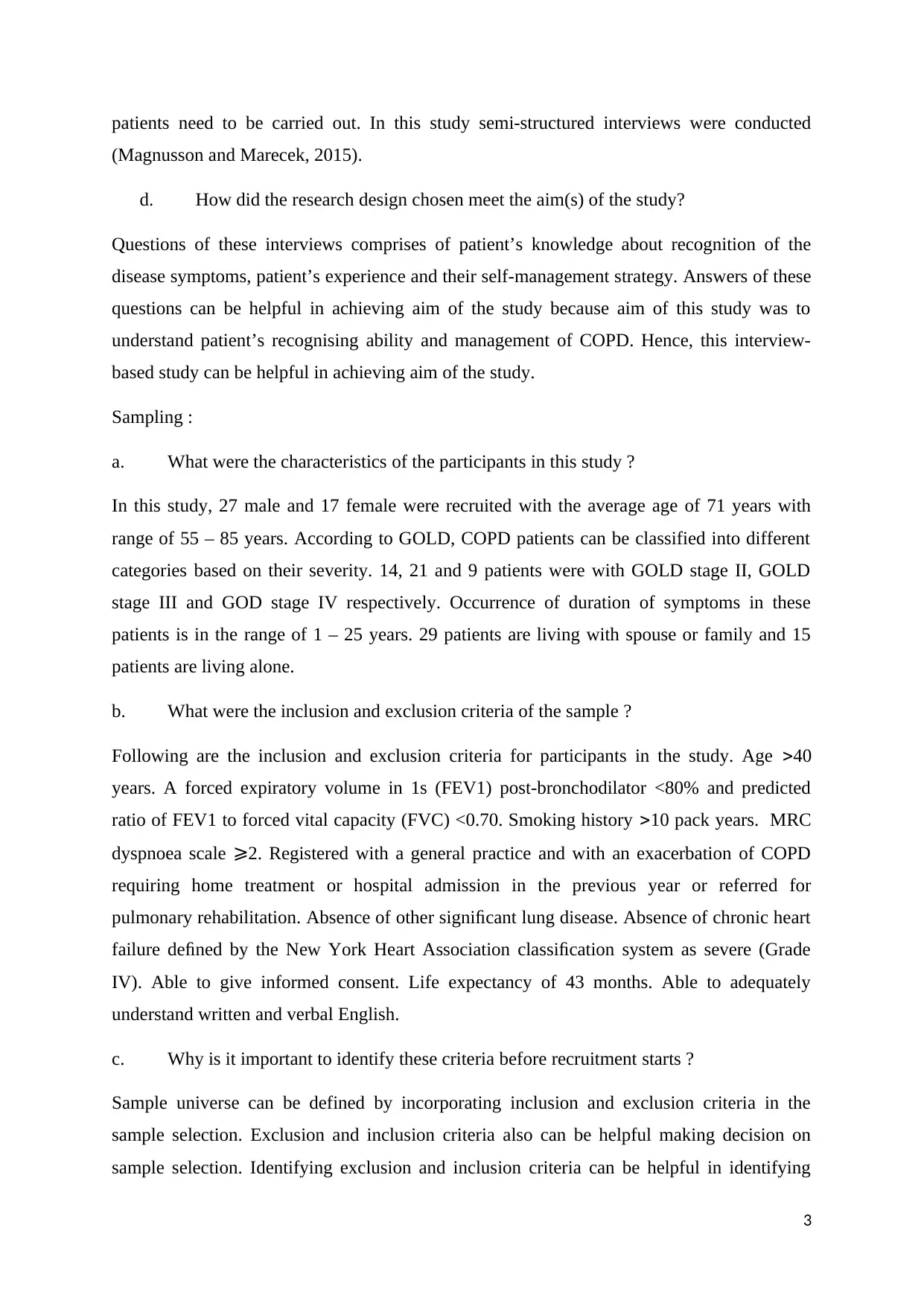
patients need to be carried out. In this study semi-structured interviews were conducted
(Magnusson and Marecek, 2015).
d. How did the research design chosen meet the aim(s) of the study?
Questions of these interviews comprises of patient’s knowledge about recognition of the
disease symptoms, patient’s experience and their self-management strategy. Answers of these
questions can be helpful in achieving aim of the study because aim of this study was to
understand patient’s recognising ability and management of COPD. Hence, this interview-
based study can be helpful in achieving aim of the study.
Sampling :
a. What were the characteristics of the participants in this study ?
In this study, 27 male and 17 female were recruited with the average age of 71 years with
range of 55 – 85 years. According to GOLD, COPD patients can be classified into different
categories based on their severity. 14, 21 and 9 patients were with GOLD stage II, GOLD
stage III and GOD stage IV respectively. Occurrence of duration of symptoms in these
patients is in the range of 1 – 25 years. 29 patients are living with spouse or family and 15
patients are living alone.
b. What were the inclusion and exclusion criteria of the sample ?
Following are the inclusion and exclusion criteria for participants in the study. Age 40
years. A forced expiratory volume in 1s (FEV1) post-bronchodilator ˂80% and predicted
ratio of FEV1 to forced vital capacity (FVC) ˂0.70. Smoking history 10 pack years. MRC
dyspnoea scale ⩾2. Registered with a general practice and with an exacerbation of COPD
requiring home treatment or hospital admission in the previous year or referred for
pulmonary rehabilitation. Absence of other significant lung disease. Absence of chronic heart
failure defined by the New York Heart Association classification system as severe (Grade
IV). Able to give informed consent. Life expectancy of 43 months. Able to adequately
understand written and verbal English.
c. Why is it important to identify these criteria before recruitment starts ?
Sample universe can be defined by incorporating inclusion and exclusion criteria in the
sample selection. Exclusion and inclusion criteria also can be helpful making decision on
sample selection. Identifying exclusion and inclusion criteria can be helpful in identifying
3
(Magnusson and Marecek, 2015).
d. How did the research design chosen meet the aim(s) of the study?
Questions of these interviews comprises of patient’s knowledge about recognition of the
disease symptoms, patient’s experience and their self-management strategy. Answers of these
questions can be helpful in achieving aim of the study because aim of this study was to
understand patient’s recognising ability and management of COPD. Hence, this interview-
based study can be helpful in achieving aim of the study.
Sampling :
a. What were the characteristics of the participants in this study ?
In this study, 27 male and 17 female were recruited with the average age of 71 years with
range of 55 – 85 years. According to GOLD, COPD patients can be classified into different
categories based on their severity. 14, 21 and 9 patients were with GOLD stage II, GOLD
stage III and GOD stage IV respectively. Occurrence of duration of symptoms in these
patients is in the range of 1 – 25 years. 29 patients are living with spouse or family and 15
patients are living alone.
b. What were the inclusion and exclusion criteria of the sample ?
Following are the inclusion and exclusion criteria for participants in the study. Age 40
years. A forced expiratory volume in 1s (FEV1) post-bronchodilator ˂80% and predicted
ratio of FEV1 to forced vital capacity (FVC) ˂0.70. Smoking history 10 pack years. MRC
dyspnoea scale ⩾2. Registered with a general practice and with an exacerbation of COPD
requiring home treatment or hospital admission in the previous year or referred for
pulmonary rehabilitation. Absence of other significant lung disease. Absence of chronic heart
failure defined by the New York Heart Association classification system as severe (Grade
IV). Able to give informed consent. Life expectancy of 43 months. Able to adequately
understand written and verbal English.
c. Why is it important to identify these criteria before recruitment starts ?
Sample universe can be defined by incorporating inclusion and exclusion criteria in the
sample selection. Exclusion and inclusion criteria also can be helpful making decision on
sample selection. Identifying exclusion and inclusion criteria can be helpful in identifying
3
⊘ This is a preview!⊘
Do you want full access?
Subscribe today to unlock all pages.

Trusted by 1+ million students worldwide
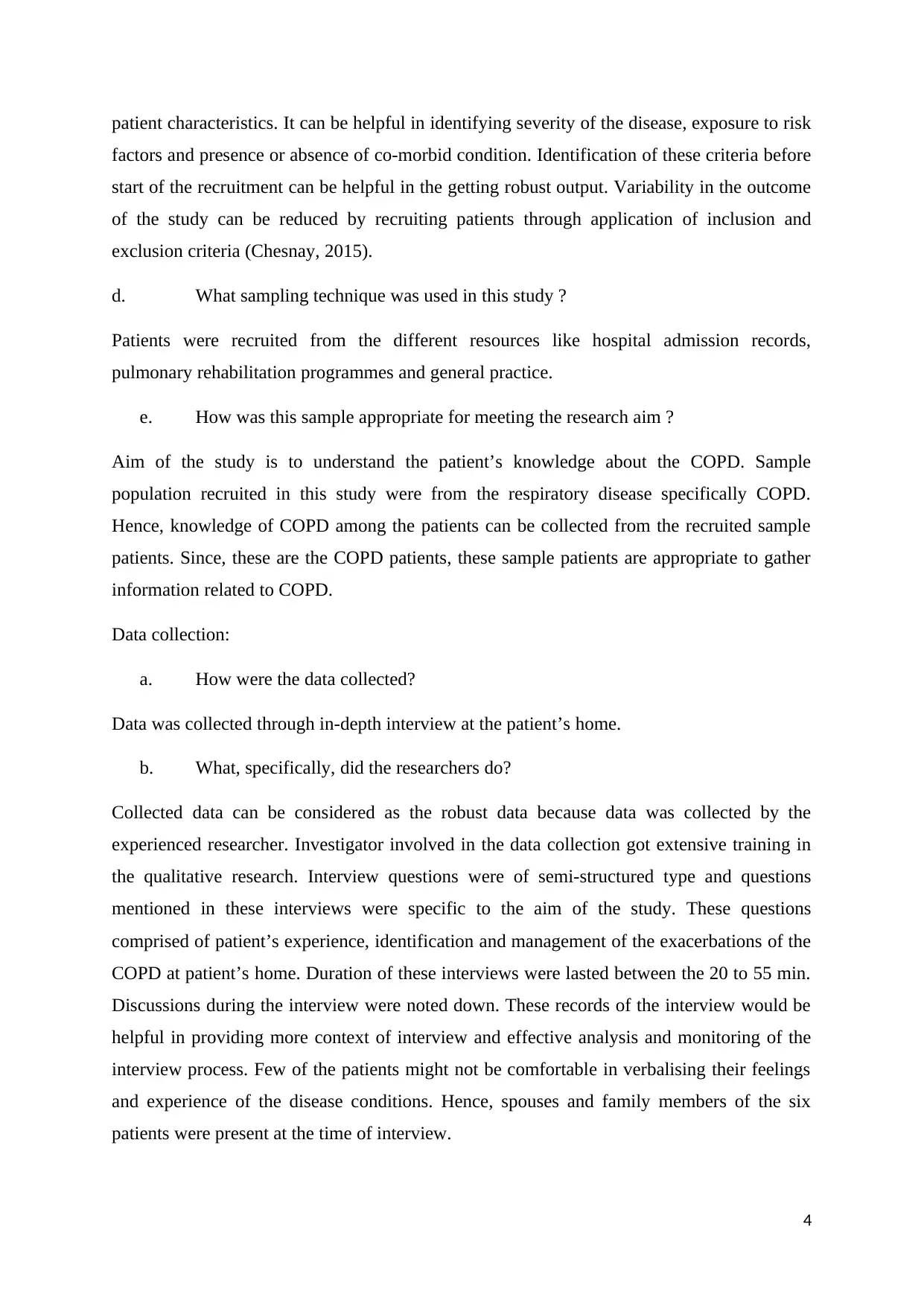
patient characteristics. It can be helpful in identifying severity of the disease, exposure to risk
factors and presence or absence of co-morbid condition. Identification of these criteria before
start of the recruitment can be helpful in the getting robust output. Variability in the outcome
of the study can be reduced by recruiting patients through application of inclusion and
exclusion criteria (Chesnay, 2015).
d. What sampling technique was used in this study ?
Patients were recruited from the different resources like hospital admission records,
pulmonary rehabilitation programmes and general practice.
e. How was this sample appropriate for meeting the research aim ?
Aim of the study is to understand the patient’s knowledge about the COPD. Sample
population recruited in this study were from the respiratory disease specifically COPD.
Hence, knowledge of COPD among the patients can be collected from the recruited sample
patients. Since, these are the COPD patients, these sample patients are appropriate to gather
information related to COPD.
Data collection:
a. How were the data collected?
Data was collected through in-depth interview at the patient’s home.
b. What, specifically, did the researchers do?
Collected data can be considered as the robust data because data was collected by the
experienced researcher. Investigator involved in the data collection got extensive training in
the qualitative research. Interview questions were of semi-structured type and questions
mentioned in these interviews were specific to the aim of the study. These questions
comprised of patient’s experience, identification and management of the exacerbations of the
COPD at patient’s home. Duration of these interviews were lasted between the 20 to 55 min.
Discussions during the interview were noted down. These records of the interview would be
helpful in providing more context of interview and effective analysis and monitoring of the
interview process. Few of the patients might not be comfortable in verbalising their feelings
and experience of the disease conditions. Hence, spouses and family members of the six
patients were present at the time of interview.
4
factors and presence or absence of co-morbid condition. Identification of these criteria before
start of the recruitment can be helpful in the getting robust output. Variability in the outcome
of the study can be reduced by recruiting patients through application of inclusion and
exclusion criteria (Chesnay, 2015).
d. What sampling technique was used in this study ?
Patients were recruited from the different resources like hospital admission records,
pulmonary rehabilitation programmes and general practice.
e. How was this sample appropriate for meeting the research aim ?
Aim of the study is to understand the patient’s knowledge about the COPD. Sample
population recruited in this study were from the respiratory disease specifically COPD.
Hence, knowledge of COPD among the patients can be collected from the recruited sample
patients. Since, these are the COPD patients, these sample patients are appropriate to gather
information related to COPD.
Data collection:
a. How were the data collected?
Data was collected through in-depth interview at the patient’s home.
b. What, specifically, did the researchers do?
Collected data can be considered as the robust data because data was collected by the
experienced researcher. Investigator involved in the data collection got extensive training in
the qualitative research. Interview questions were of semi-structured type and questions
mentioned in these interviews were specific to the aim of the study. These questions
comprised of patient’s experience, identification and management of the exacerbations of the
COPD at patient’s home. Duration of these interviews were lasted between the 20 to 55 min.
Discussions during the interview were noted down. These records of the interview would be
helpful in providing more context of interview and effective analysis and monitoring of the
interview process. Few of the patients might not be comfortable in verbalising their feelings
and experience of the disease conditions. Hence, spouses and family members of the six
patients were present at the time of interview.
4
Paraphrase This Document
Need a fresh take? Get an instant paraphrase of this document with our AI Paraphraser
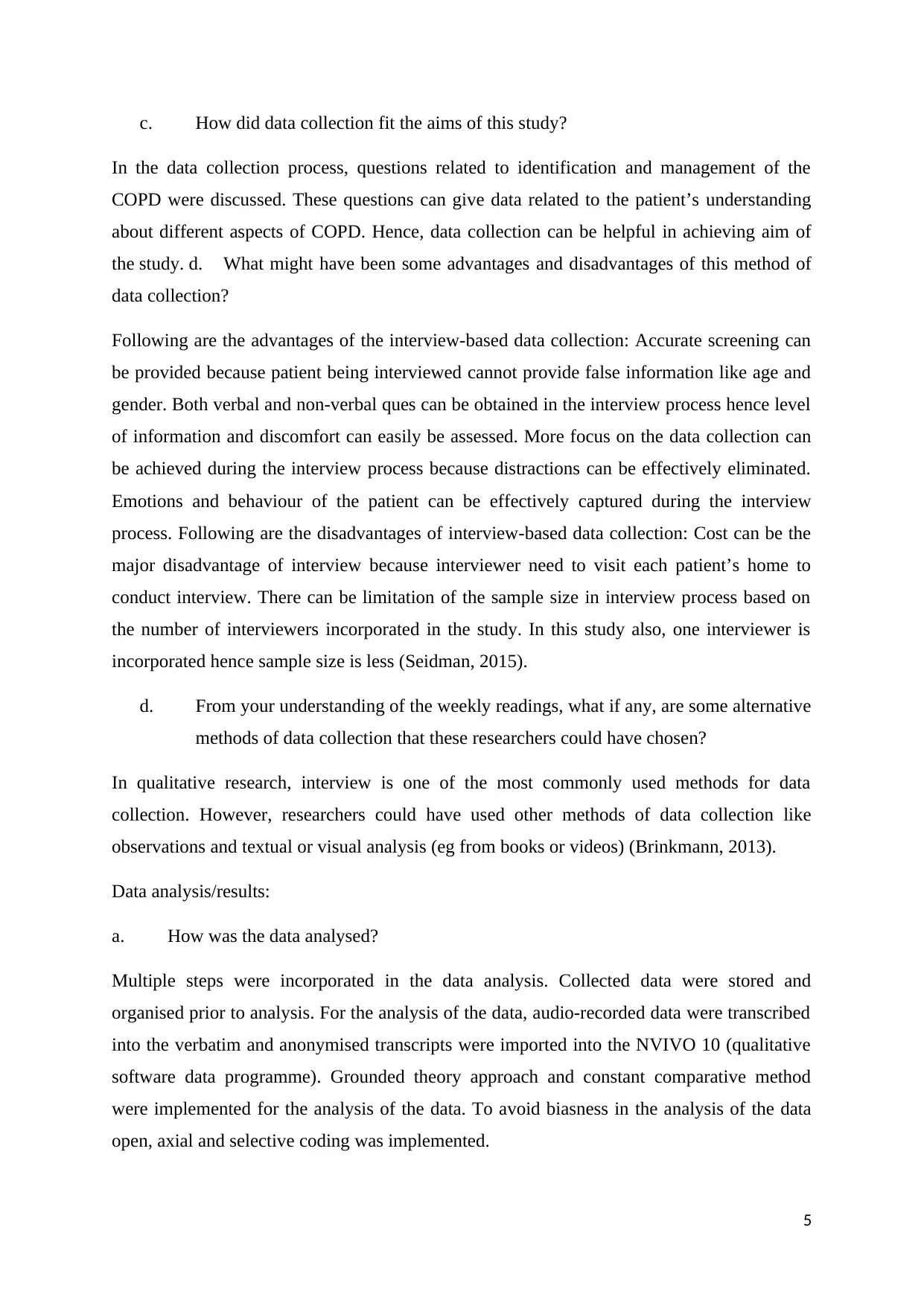
c. How did data collection fit the aims of this study?
In the data collection process, questions related to identification and management of the
COPD were discussed. These questions can give data related to the patient’s understanding
about different aspects of COPD. Hence, data collection can be helpful in achieving aim of
the study. d. What might have been some advantages and disadvantages of this method of
data collection?
Following are the advantages of the interview-based data collection: Accurate screening can
be provided because patient being interviewed cannot provide false information like age and
gender. Both verbal and non-verbal ques can be obtained in the interview process hence level
of information and discomfort can easily be assessed. More focus on the data collection can
be achieved during the interview process because distractions can be effectively eliminated.
Emotions and behaviour of the patient can be effectively captured during the interview
process. Following are the disadvantages of interview-based data collection: Cost can be the
major disadvantage of interview because interviewer need to visit each patient’s home to
conduct interview. There can be limitation of the sample size in interview process based on
the number of interviewers incorporated in the study. In this study also, one interviewer is
incorporated hence sample size is less (Seidman, 2015).
d. From your understanding of the weekly readings, what if any, are some alternative
methods of data collection that these researchers could have chosen?
In qualitative research, interview is one of the most commonly used methods for data
collection. However, researchers could have used other methods of data collection like
observations and textual or visual analysis (eg from books or videos) (Brinkmann, 2013).
Data analysis/results:
a. How was the data analysed?
Multiple steps were incorporated in the data analysis. Collected data were stored and
organised prior to analysis. For the analysis of the data, audio-recorded data were transcribed
into the verbatim and anonymised transcripts were imported into the NVIVO 10 (qualitative
software data programme). Grounded theory approach and constant comparative method
were implemented for the analysis of the data. To avoid biasness in the analysis of the data
open, axial and selective coding was implemented.
5
In the data collection process, questions related to identification and management of the
COPD were discussed. These questions can give data related to the patient’s understanding
about different aspects of COPD. Hence, data collection can be helpful in achieving aim of
the study. d. What might have been some advantages and disadvantages of this method of
data collection?
Following are the advantages of the interview-based data collection: Accurate screening can
be provided because patient being interviewed cannot provide false information like age and
gender. Both verbal and non-verbal ques can be obtained in the interview process hence level
of information and discomfort can easily be assessed. More focus on the data collection can
be achieved during the interview process because distractions can be effectively eliminated.
Emotions and behaviour of the patient can be effectively captured during the interview
process. Following are the disadvantages of interview-based data collection: Cost can be the
major disadvantage of interview because interviewer need to visit each patient’s home to
conduct interview. There can be limitation of the sample size in interview process based on
the number of interviewers incorporated in the study. In this study also, one interviewer is
incorporated hence sample size is less (Seidman, 2015).
d. From your understanding of the weekly readings, what if any, are some alternative
methods of data collection that these researchers could have chosen?
In qualitative research, interview is one of the most commonly used methods for data
collection. However, researchers could have used other methods of data collection like
observations and textual or visual analysis (eg from books or videos) (Brinkmann, 2013).
Data analysis/results:
a. How was the data analysed?
Multiple steps were incorporated in the data analysis. Collected data were stored and
organised prior to analysis. For the analysis of the data, audio-recorded data were transcribed
into the verbatim and anonymised transcripts were imported into the NVIVO 10 (qualitative
software data programme). Grounded theory approach and constant comparative method
were implemented for the analysis of the data. To avoid biasness in the analysis of the data
open, axial and selective coding was implemented.
5
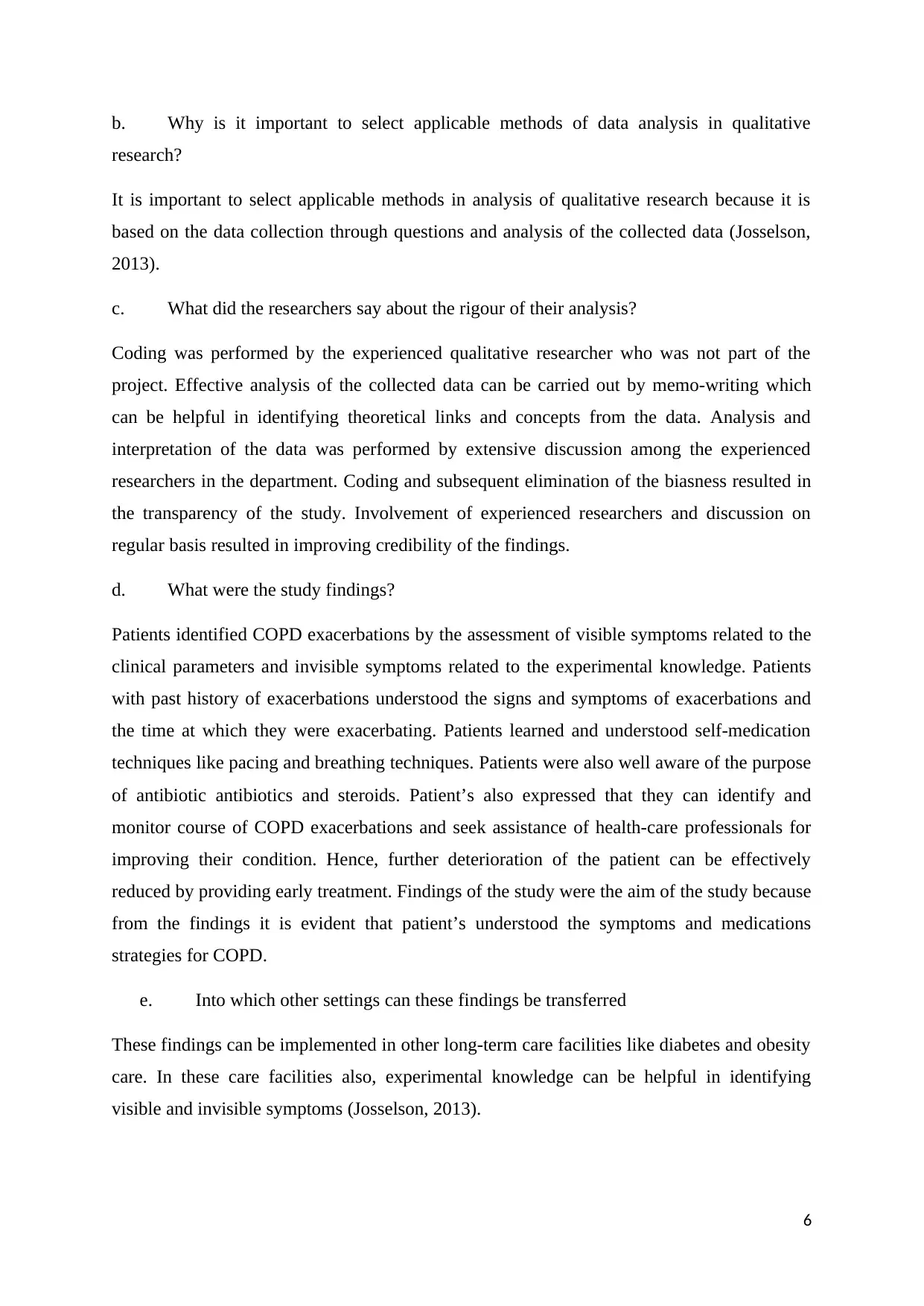
b. Why is it important to select applicable methods of data analysis in qualitative
research?
It is important to select applicable methods in analysis of qualitative research because it is
based on the data collection through questions and analysis of the collected data (Josselson,
2013).
c. What did the researchers say about the rigour of their analysis?
Coding was performed by the experienced qualitative researcher who was not part of the
project. Effective analysis of the collected data can be carried out by memo-writing which
can be helpful in identifying theoretical links and concepts from the data. Analysis and
interpretation of the data was performed by extensive discussion among the experienced
researchers in the department. Coding and subsequent elimination of the biasness resulted in
the transparency of the study. Involvement of experienced researchers and discussion on
regular basis resulted in improving credibility of the findings.
d. What were the study findings?
Patients identified COPD exacerbations by the assessment of visible symptoms related to the
clinical parameters and invisible symptoms related to the experimental knowledge. Patients
with past history of exacerbations understood the signs and symptoms of exacerbations and
the time at which they were exacerbating. Patients learned and understood self-medication
techniques like pacing and breathing techniques. Patients were also well aware of the purpose
of antibiotic antibiotics and steroids. Patient’s also expressed that they can identify and
monitor course of COPD exacerbations and seek assistance of health-care professionals for
improving their condition. Hence, further deterioration of the patient can be effectively
reduced by providing early treatment. Findings of the study were the aim of the study because
from the findings it is evident that patient’s understood the symptoms and medications
strategies for COPD.
e. Into which other settings can these findings be transferred
These findings can be implemented in other long-term care facilities like diabetes and obesity
care. In these care facilities also, experimental knowledge can be helpful in identifying
visible and invisible symptoms (Josselson, 2013).
6
research?
It is important to select applicable methods in analysis of qualitative research because it is
based on the data collection through questions and analysis of the collected data (Josselson,
2013).
c. What did the researchers say about the rigour of their analysis?
Coding was performed by the experienced qualitative researcher who was not part of the
project. Effective analysis of the collected data can be carried out by memo-writing which
can be helpful in identifying theoretical links and concepts from the data. Analysis and
interpretation of the data was performed by extensive discussion among the experienced
researchers in the department. Coding and subsequent elimination of the biasness resulted in
the transparency of the study. Involvement of experienced researchers and discussion on
regular basis resulted in improving credibility of the findings.
d. What were the study findings?
Patients identified COPD exacerbations by the assessment of visible symptoms related to the
clinical parameters and invisible symptoms related to the experimental knowledge. Patients
with past history of exacerbations understood the signs and symptoms of exacerbations and
the time at which they were exacerbating. Patients learned and understood self-medication
techniques like pacing and breathing techniques. Patients were also well aware of the purpose
of antibiotic antibiotics and steroids. Patient’s also expressed that they can identify and
monitor course of COPD exacerbations and seek assistance of health-care professionals for
improving their condition. Hence, further deterioration of the patient can be effectively
reduced by providing early treatment. Findings of the study were the aim of the study because
from the findings it is evident that patient’s understood the symptoms and medications
strategies for COPD.
e. Into which other settings can these findings be transferred
These findings can be implemented in other long-term care facilities like diabetes and obesity
care. In these care facilities also, experimental knowledge can be helpful in identifying
visible and invisible symptoms (Josselson, 2013).
6
⊘ This is a preview!⊘
Do you want full access?
Subscribe today to unlock all pages.

Trusted by 1+ million students worldwide
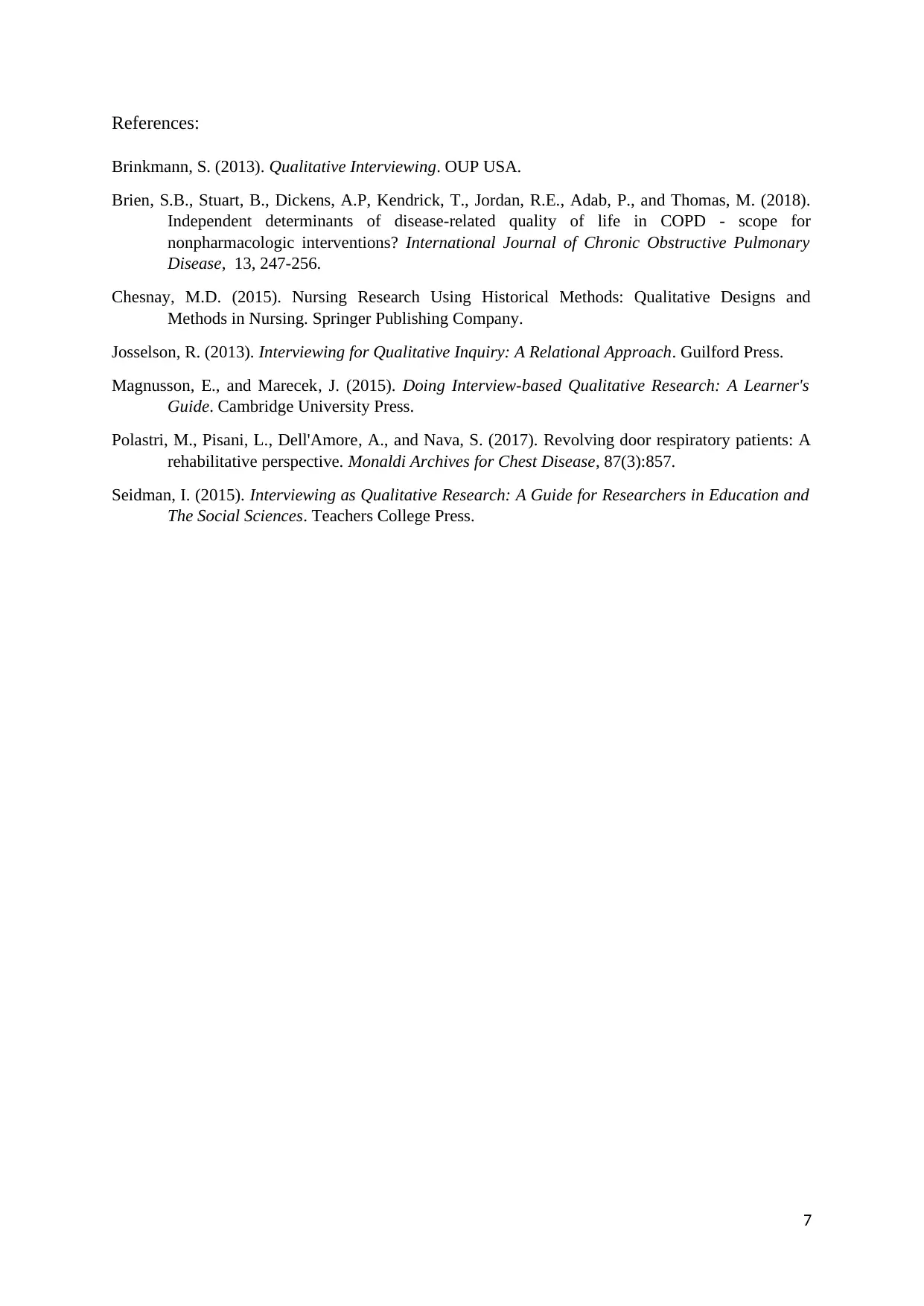
References:
Brinkmann, S. (2013). Qualitative Interviewing. OUP USA.
Brien, S.B., Stuart, B., Dickens, A.P, Kendrick, T., Jordan, R.E., Adab, P., and Thomas, M. (2018).
Independent determinants of disease-related quality of life in COPD - scope for
nonpharmacologic interventions? International Journal of Chronic Obstructive Pulmonary
Disease, 13, 247-256.
Chesnay, M.D. (2015). Nursing Research Using Historical Methods: Qualitative Designs and
Methods in Nursing. Springer Publishing Company.
Josselson, R. (2013). Interviewing for Qualitative Inquiry: A Relational Approach. Guilford Press.
Magnusson, E., and Marecek, J. (2015). Doing Interview-based Qualitative Research: A Learner's
Guide. Cambridge University Press.
Polastri, M., Pisani, L., Dell'Amore, A., and Nava, S. (2017). Revolving door respiratory patients: A
rehabilitative perspective. Monaldi Archives for Chest Disease, 87(3):857.
Seidman, I. (2015). Interviewing as Qualitative Research: A Guide for Researchers in Education and
The Social Sciences. Teachers College Press.
7
Brinkmann, S. (2013). Qualitative Interviewing. OUP USA.
Brien, S.B., Stuart, B., Dickens, A.P, Kendrick, T., Jordan, R.E., Adab, P., and Thomas, M. (2018).
Independent determinants of disease-related quality of life in COPD - scope for
nonpharmacologic interventions? International Journal of Chronic Obstructive Pulmonary
Disease, 13, 247-256.
Chesnay, M.D. (2015). Nursing Research Using Historical Methods: Qualitative Designs and
Methods in Nursing. Springer Publishing Company.
Josselson, R. (2013). Interviewing for Qualitative Inquiry: A Relational Approach. Guilford Press.
Magnusson, E., and Marecek, J. (2015). Doing Interview-based Qualitative Research: A Learner's
Guide. Cambridge University Press.
Polastri, M., Pisani, L., Dell'Amore, A., and Nava, S. (2017). Revolving door respiratory patients: A
rehabilitative perspective. Monaldi Archives for Chest Disease, 87(3):857.
Seidman, I. (2015). Interviewing as Qualitative Research: A Guide for Researchers in Education and
The Social Sciences. Teachers College Press.
7
1 out of 7
Related Documents
Your All-in-One AI-Powered Toolkit for Academic Success.
+13062052269
info@desklib.com
Available 24*7 on WhatsApp / Email
![[object Object]](/_next/static/media/star-bottom.7253800d.svg)
Unlock your academic potential
Copyright © 2020–2025 A2Z Services. All Rights Reserved. Developed and managed by ZUCOL.





